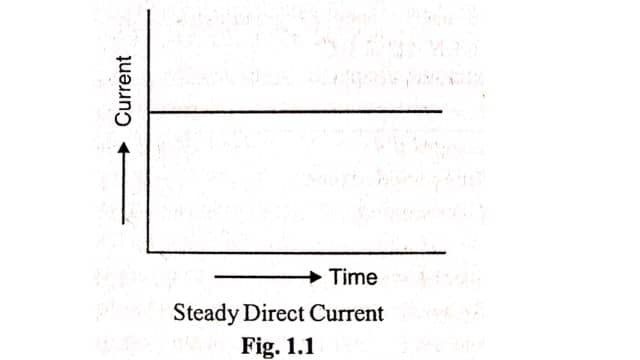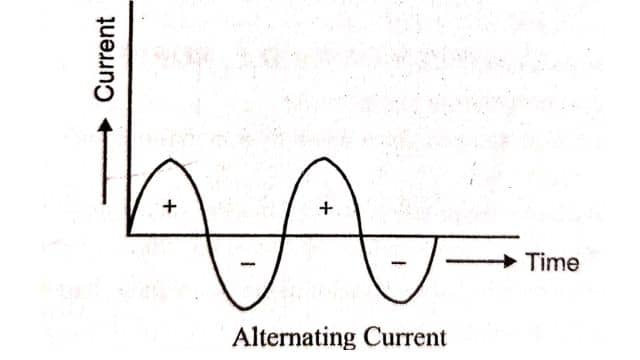
Table of Contents
In a closed circuit, an electric current is the flow of electrons. There are two kinds of electric currents Direct current (D.C) and Alternating current (A.C)
1. Direct Current: In alternating current, the electric charge flow changes its direction periodically. AC is the most commonly used and most-preferred electric power for household equipment, office, buildings, etc. It was first tested based on the principles of Michael Faraday in 1832 using a Dynamo Electric Generator.
A direct current has the following characteristics:
(1) It flows in one direction only.
(ii) It always flows from the +ve terminal to the -ve terminal of the supply.
(iii) It may or may not have constant value and thus direct current may be-
(a) Steady D.C.
(b) Pulsating D.C.
A direct current that has a constant magnitude is called steady D.C. A graph of steady D.C. is drawn between the current( along Y-axis) and time along X-axis. This graph will be a straight line that is parallel to X-axis as shown in Fig.

A direct current that changes in magnitude with the passage of time but flows in the same direction in the circuit is called Pulsating direct current. A pulsating D.C. is shown in Figure.

Unless it is mentioned, D.C. means steady direct current. D.C. is supplied by cells, secondary batteries, and D.C. generators. A circuit that carries D.C. is called a D.C. circuit.
2. Alternating Current: Unlike alternating current, the flow of direct current does not change periodically. The current electricity flows in a single direction in a steady voltage. The major use of DC is to supply power to electrical devices and also to charge batteries. Examples: mobile phone batteries, flashlights, flat-screen television, and electric vehicles.
An alternating current has the following characteristics:
(1) It changes its direction periodically.
(ii) It also changes its magnitude with time. An alternating current is shown in Figure.
An alternating current is shown in Figure.

A.C. is supplied by an A.C. generator. A circuit that is supplied with A.C. is called an A.C. circuit. Supply from the A.C. generator not only changes in magnitude at every instant but also changes its direction.
Advantages of A.C. Supply Over D.C. Supply
A few advantages of a.c. supply over d.c. supply are:
- A.C. supply voltage can be stepped up or down by a transformer, which is impossible in the case of d.c. supply.
- For a given machine size, the power generated in a three-phase alternator is three times higher than that of d.c. generator.
- Generation of power at high voltages is easier in the case of a.c. then in the case of d.c. generation. It is because of the commutation problem in d.c.
- For transmitting a given amount of power over a given distance at a given voltage and with the same efficiency, the conductor material required in the case of three-phase a.c. is less than that required in two-wire d.c.
- In the case of 3 phase, 4-wire system two voltages that are 230 V and 400 V can be obtained which is not possible in d.c.
- A.C. motors are simple in construction, rugged, and require less maintenance.
Advantages of D.C. Over A.C
A few advantages of d.c. over a.c. are –
- In industries a.c. is used but in some applications like battery charging, electroplating, electrolysis, etc. only d.c. supply is suitable.
- For speed controls over a wide range d.c. motors are better suited.
- In a.c. lines if there is no load at receiving end, even then charging current flows. But in d.c. lines if there is no load at receiving end, no current flows through the line.
- In A.C. lines alternating current flows which produces alternating flux. The alternating flux interferes with telephone lines. This problem is not there in D.C. lines.
- In a.c. lines, eddy current loss, and dielectric loss occur whereas such losses are not in d.c. lines.
Frequently Asked Questions (FAQs)
What are the advantages of AC over DC?
1. The AC is simpler to produce than DC. It is also less expensive than DC to generate.
2. AC systems have higher efficiency than DC such as ac generators.What is wattless current?
Wattless current is defined as the current in an AC circuit when the average power consumption is zero.
What will be the value of the power factor in the circuit when it is at resonance?
The value of the power factor in the circuit when it is at resonance will be 1.
Read Also:
- Electrical Energy | Its Unit and Examples
- Advantages of Electric Heating
- Difference Between AC and DC Welding







Leave a Reply